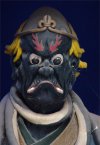My interest in the hell scrolls began in the summer of 1965 when I attended a New York State grant session at NYU under the direction and instruction of professor Li, from the U. of Iowa (at that time) with lectures from the renowned Prof. Soper from NYU. It lasted all summer and the chosen professors from New York colleges attended classes and visited collections in New York at the Met plus private collections, Harvard in Boston and U. of Pennsylvania in Philadelphia. Mostly the study was comprehensive about all Chinese painting and crafts, history and culture. There were some of us, mostly myself and the New York artist Alan Kaprow who were especially interested in the color and subject matter of the hell scrolls. From this introduction, I was chosen the following summer of 1966 to study at the Palace Museum in Taipei, under the instruction of Tom Lawton, who eventually was the curator at the Freer Museum in Washington, D.C. The hell scrolls were a small part of the visual art group (5 of us of the 25 who studied there that summer under a Fulbright-Hays Scholarship). My study of those scrolls were done in galleries in Taipei, the Palace Museum, Tai Chung, Tainan, I-Lan, and other small towns along the coast of Taiwan. We had one lecture by the author of Sin and Guilt in Traditional China (from a now extinct book that he published, cannot remember his name) which interested me more in the scrolls themselves, not just the history behind them. I tried to purchase some scrolls after seeing some examples at the Palace Museum and in temples along our travels, but was told: “These kind of scrolls are no longer made and the older ones are not available.”
 |
In 1969, I was appointed director of the Fine Arts Department (visual arts, music and theater) at the University of Guam. From that time until I left in 1976, I went to Taiwan and Hong Kong at least three times a year, staying in the summer for three to four weeks (taking 20 students there in 1973 and 1975 for study). I remembered what I had been told about the lack of possibility to collect these hell scrolls but by searching all the galleries along the main street in Taipei and the other cities we visited, also going to “hagglers’ alley (booths set up each Saturday of private goods from the country), I found a few (2-3 single scrolls and the puppets that told their stories but no collect sets). I found some in Hong Kong also but again only a few from a broken set (said to be done in the 19th century but I was sure from style, condition and paper that they were mid 20th). Then I saw a recent set in a temple in I-Lan, on the eastern coast of Taiwan, across the Cross Island Highway (when it was a road that only went one way in the morning and one in the afternoon- which was sometimes not honored). I got the name of the painter and his sons, met them and ordered a newly painted set of the collect scrolls to be painted. It took half a year but they were beautifully painted (I still own that set). As I remember, that set cost $500 to collect in 1972. The painter was said to be the last of the Hell Scroll artists (he was in his 80’s then and soon died after completing my order). I showed the finished set at the National Museum in the park behind Liberty House where my family stayed while in Taipei. All at once other private collections of Hell Scrolls were surprisingly found and offered to me. I choose to buy the best from private collectors, galleries, etc. from Taipei (the biggest source) to Tainan. I bought eight complete sets (10 scrolls in a set) which I suspect were brought from the mainland by the fleeing Chinese from Communists, placed in attics and sometimes forgotten by the children of the parents or grandparents who brought them over. I cannot tell the actual dating of the works but most can be placed in the 19th century with some surety (although I was told that some were older than that but I could not authenticate that dating except by style). Also I bought single or double scrolls which depicted the gods of hell (I use the word “hell” although that is not the way that they were presented to me- they were “Scrolls from the Underworld”). It is during that time that I began my research comparing these depictions to Dante’s concepts of hell. I estimate that I spent between $1000-10,000 dollars a year collecting Chinese art in Taiwan and Hong Kong (living on Guam and teaching oriental art and having no museums there to use for my students, I was able to take this off my income tax as a teaching expense). Also at that time, I was working on the side for Chinese and Japanese businesses with my own art so I was making exceptional money which had to be spent or I would pay it in taxes.
I showed the scrolls to Tom Lawton at the Freer Museum in Washington and he felt that they were done by peasant artists or artisans, not royal painters, but that is exactly what I thought and wanted at that time. I was interested in the use of color as compared to some of my fellow artists painting in New York as Abstract Expressionists. I have used the scrolls in this kind of comparison since the 1970’s with my students (while also running classes at the museums where I was curator and director). They have been shown twice at museums as my collection (approx. 50-80 at one time but less now).
My children do not have the passion for the scrolls that I have therefore I started selling my total collection (including the scrolls in the 1980’s). Because of the nature of the subject matter of the hell scrolls, they did not sell and that suited my teaching and love of them. I sold all the Hell Puppets in the late 1990’s and the first set of the total series to Prof. Ken Brashier of Reed College in recent years.
The process of collecting scrolls was interesting. It takes patience and the time to build trust. It took me years to acquire the first set, painted by the last of the hell scroll painters in I-Lan, and then I began to hear about more sets. But even then I was shown inferior sets in the main showroom of a commercial gallery. It was only later, after the owner knew that I knew what “the best of the best” looked like, that other rooms were opened to me in the backs of the gallery, and finally drawers of work that few saw. The cheapest set was gotten for under $50 and a white shirt that I was wearing at the time; the most expensive in 1970’s was over $3000. I traveled to Taiwan each year from 1970-1976 and Hong Kong from 1972-76, searching the galleries and talking to academicians about private collections. I had one dealer in Taipei who knew my passion and searched for them for me (cannot remember his name but I do remember the small one room of his establishment).

